UV Fused Silica High-Precision Windows
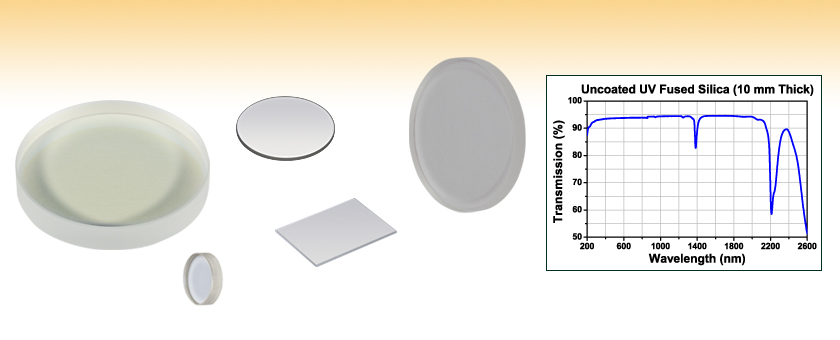
- Round and Rectangular Windows Designed for 185 nm to 2.1 µm
- Uncoated and AR-Coated Versions Available
- Five Sizes Available
WG42012-B
(Ø2")
WG41010-A
(Ø1")
WG40530-UV
(Ø1/2")
WG41010R
(25 mm x 36 mm)
VPW42
(Ø1.5")

Please Wait
| Flat Window Selection Guide | |
|---|---|
| Wavelength Range | Substrate Material |
| 180 nm - 8.0 μm | Calcium Fluoride (CaF2) |
| 185 nm - 2.1 μm | UV Fused Silica |
| 200 nm - 5.0 μm | Sapphire |
| 200 nm - 6.0 μm | Magnesium Fluoride (MgF2) |
| 220 nm to >50 µm | CVD Diamond Windows |
| 230 nm - 1.1 µm | UV Fused Silica, Textured Antireflective Surface |
| 250 nm - 1.6 µm | UV Fused Silica, for 45° AOI |
| 250 nm - 26 µm | Potassium Bromide (KBr) |
| 300 nm - 3 µm | Infrasil® |
| 350 nm - 2.0 μm | N-BK7 |
| 600 nm - 16 µm | Zinc Selenide (ZnSe) |
| 1 - 1.7 µm | Infrasil®, Textured Antireflective Surface |
| 1.2 - 8.0 μm | Silicon (Si) |
| 1.9 - 16 μm | Germanium (Ge) |
| 2 - 5 μm | Barium Fluoride (BaF2) |
| V-Coated Laser Windows | |
Features
- Five Sizes Available
-
- Ø1/2": 3.0 mm Thick
- Ø1": 1.0 mm or 5.0 mm Thick
- 25 mm x 36 mm: 1.0 mm Thick
- Ø1.5": 4.04 mm Thick
- Ø2": 12.0 mm Thick
- Available Uncoated or with One of Four Broadband AR Coatings
-
- 245 - 400 nm (-UV Coating Designation)
- 350 - 700 nm (-A Coating Designation)
- 650 - 1050 nm (-B Coating Designation)
- 1050 - 1700 nm (-C Coating Designation)
Thorlabs' UV Fused Silica High-Precision Windows are available in four sizes ranging from Ø1/2" to Ø2" and a rectangular 25 mm x 36 mm size. Round windows can be purchased from stock uncoated (185 nm - 2.1 μm) or with one of our four low-loss standard broadband antireflection coatings deposited on both surfaces: -UV (245 - 400 nm), -A (350 - 700 nm), -B (650 - 1050 nm), or -C (1050 - 1700 nm). While uncoated windows have typical losses of about 4% per surface, the AR coatings reduce this to Ravg < 0.5%. These AR coatings provide good performance for angles of incidence (AOI) between 0° and 30°. For additional information on these coatings, please see the Graphs tab.
The Ø1" and 25 mm x 36 mm windows are available with a 1.0 mm thick substrate. 1.0 mm thick windows are ideal for ultrafast applications or in situations where space is limited. We recommend mounting the thin, round windows in our LMR1 or LMR1/M Fixed Lens Mount and securing them with a SM1LTRR Stress-Free Retaining Ring.
UV-grade fused silica is well-suited for applications that benefit from increased transmission deeper into the UV than N-BK7. UV fused silica also offers a lower index of refraction for a given wavelength, better homogeneity, and a lower coefficient of thermal expansion than N-BK7.
Thorlabs offers High-Precision Windows fabricated from various substrate materials for use in a large variety of laser and industrial applications. We also offer laser windows and wedged laser windows, which have wavelength-specific AR coatings centered around commonly used laser wavelengths, and Brewster windows, which eliminate p-polarization reflectance. Additionally, our Ø1.5" windows are ideal as replacement windows on our high-vacuum CF flange viewports.
All of the round UVFS windows can be ordered from stock uncoated or with one of the following broadband AR coatings: 245 - 400 nm (designated as -UV), 350 - 700 nm (designated as -A), 650 - 1050 nm (designated as -B), or 1050 - 1700 nm (designated as -C).
Thorlabs' high-performance multilayer AR coatings have an average reflectance of less than 0.5% (per surface) across the specified wavelength ranges (denoted by the shaded blue area in the Coating graphs below). These AR coatings provide good performance for angles of incidence (AOI) between 0° - 30° (0.5 NA). The substrate transmission graph below shows the transmission of light through an uncoated UVFS substrate. For optics intended to be used at larger incident angles, consider ordering a custom coating optimized for a 45° angle of incidence; these coatings are recommended for use with incidence angles from 25° to 52°. Please contact Tech Support to order optics with custom coatings.
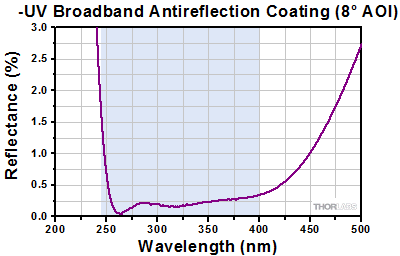
Click to Enlarge
Click for Raw Data
The blue shaded region indicates the specified 245 - 400 nm wavelength range for optimum performance.
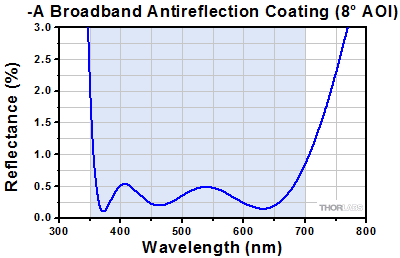
Click to Enlarge
Click for Raw Data
The blue shaded region indicates the specified 350 - 700 nm wavelength range for optimum performance.
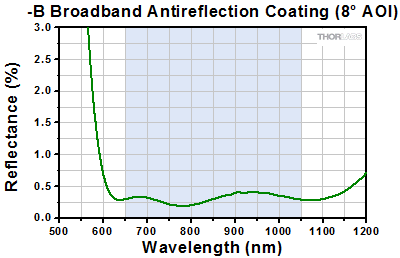
Click to Enlarge
Click for Raw Data
The blue shaded region indicates the specified 650 - 1050 nm wavelength range for optimum performance.
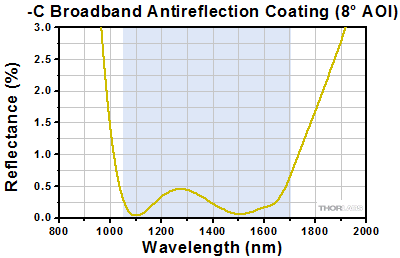
Click to Enlarge
Click for Raw Data
The blue shaded region indicates the specified 1050 - 1700 nm wavelength range for optimum performance.
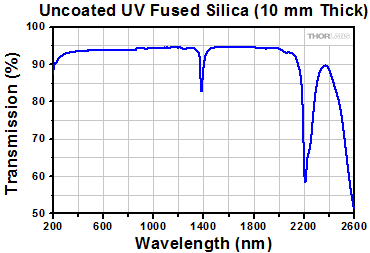
Click to Enlarge
Click for Raw Data
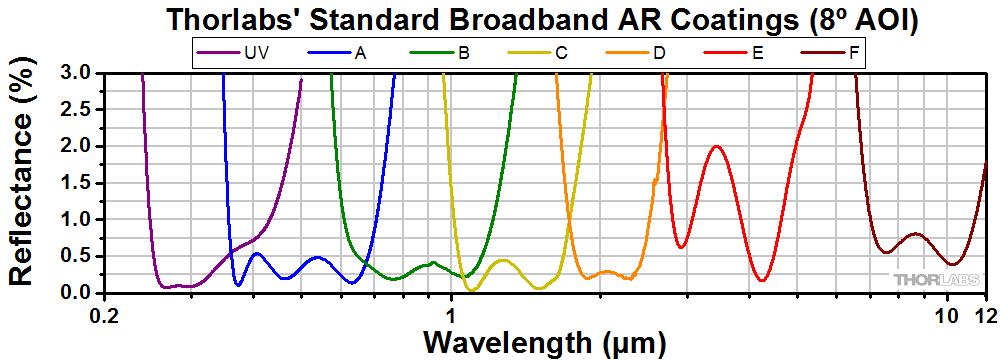
| Damage Threshold Specifications | ||
|---|---|---|
| Coating Designation (Item # Suffix) |
Damage Threshold | |
| -UV | Pulse | 5.0 J/cm2 at 355 nm, 10 ns, 10 Hz, Ø0.350 mm |
| -A | Pulse | 7.5 J/cm2 at 532 nm, 10 ns, 10 Hz, Ø0.491 mm |
| CWa,b | 550 W/cm (532 nm, Ø1.000 mm) | |
| -B | Pulse | 0.246 J/cm2 at 800 nm, 99 fs, 1 kHz, Ø0.166 mm 7.5 J/cm2 at 810 nm, 10 ns, 10 Hz, Ø0.133 mm |
| CWa,b | 20 kW/cm (1070 nm, Ø0.974 mm) | |
| -C | Pulse | 7.5 J/cm2 at 1542 nm, 10 ns, 10 Hz, Ø0.189 mm |
| CWa,b | 350 W/cm (1540 nm, Ø1.030 mm) | |
Damage Threshold Data for Thorlabs' UV Fused Silica Windows
The specifications to the right are measured data for Thorlabs' UV fused silica windows. Damage threshold specifications are constant for a given coating type, regardless of the size of the window.
Laser Induced Damage Threshold Tutorial
The following is a general overview of how laser induced damage thresholds are measured and how the values may be utilized in determining the appropriateness of an optic for a given application. When choosing optics, it is important to understand the Laser Induced Damage Threshold (LIDT) of the optics being used. The LIDT for an optic greatly depends on the type of laser you are using. Continuous wave (CW) lasers typically cause damage from thermal effects (absorption either in the coating or in the substrate). Pulsed lasers, on the other hand, often strip electrons from the lattice structure of an optic before causing thermal damage. Note that the guideline presented here assumes room temperature operation and optics in new condition (i.e., within scratch-dig spec, surface free of contamination, etc.). Because dust or other particles on the surface of an optic can cause damage at lower thresholds, we recommend keeping surfaces clean and free of debris. For more information on cleaning optics, please see our Optics Cleaning tutorial.
Testing Method
Thorlabs' LIDT testing is done in compliance with ISO/DIS 11254 and ISO 21254 specifications.
First, a low-power/energy beam is directed to the optic under test. The optic is exposed in 10 locations to this laser beam for 30 seconds (CW) or for a number of pulses (pulse repetition frequency specified). After exposure, the optic is examined by a microscope (~100X magnification) for any visible damage. The number of locations that are damaged at a particular power/energy level is recorded. Next, the power/energy is either increased or decreased and the optic is exposed at 10 new locations. This process is repeated until damage is observed. The damage threshold is then assigned to be the highest power/energy that the optic can withstand without causing damage. A histogram such as that below represents the testing of one BB1-E02 mirror.

The photograph above is a protected aluminum-coated mirror after LIDT testing. In this particular test, it handled 0.43 J/cm2 (1064 nm, 10 ns pulse, 10 Hz, Ø1.000 mm) before damage.

| Example Test Data | |||
|---|---|---|---|
| Fluence | # of Tested Locations | Locations with Damage | Locations Without Damage |
| 1.50 J/cm2 | 10 | 0 | 10 |
| 1.75 J/cm2 | 10 | 0 | 10 |
| 2.00 J/cm2 | 10 | 0 | 10 |
| 2.25 J/cm2 | 10 | 1 | 9 |
| 3.00 J/cm2 | 10 | 1 | 9 |
| 5.00 J/cm2 | 10 | 9 | 1 |
According to the test, the damage threshold of the mirror was 2.00 J/cm2 (532 nm, 10 ns pulse, 10 Hz, Ø0.803 mm). Please keep in mind that these tests are performed on clean optics, as dirt and contamination can significantly lower the damage threshold of a component. While the test results are only representative of one coating run, Thorlabs specifies damage threshold values that account for coating variances.
Continuous Wave and Long-Pulse Lasers
When an optic is damaged by a continuous wave (CW) laser, it is usually due to the melting of the surface as a result of absorbing the laser's energy or damage to the optical coating (antireflection) [1]. Pulsed lasers with pulse lengths longer than 1 µs can be treated as CW lasers for LIDT discussions.
When pulse lengths are between 1 ns and 1 µs, laser-induced damage can occur either because of absorption or a dielectric breakdown (therefore, a user must check both CW and pulsed LIDT). Absorption is either due to an intrinsic property of the optic or due to surface irregularities; thus LIDT values are only valid for optics meeting or exceeding the surface quality specifications given by a manufacturer. While many optics can handle high power CW lasers, cemented (e.g., achromatic doublets) or highly absorptive (e.g., ND filters) optics tend to have lower CW damage thresholds. These lower thresholds are due to absorption or scattering in the cement or metal coating.

LIDT in linear power density vs. pulse length and spot size. For long pulses to CW, linear power density becomes a constant with spot size. This graph was obtained from [1].

Pulsed lasers with high pulse repetition frequencies (PRF) may behave similarly to CW beams. Unfortunately, this is highly dependent on factors such as absorption and thermal diffusivity, so there is no reliable method for determining when a high PRF laser will damage an optic due to thermal effects. For beams with a high PRF both the average and peak powers must be compared to the equivalent CW power. Additionally, for highly transparent materials, there is little to no drop in the LIDT with increasing PRF.
In order to use the specified CW damage threshold of an optic, it is necessary to know the following:
- Wavelength of your laser
- Beam diameter of your beam (1/e2)
- Approximate intensity profile of your beam (e.g., Gaussian)
- Linear power density of your beam (total power divided by 1/e2 beam diameter)
Thorlabs expresses LIDT for CW lasers as a linear power density measured in W/cm. In this regime, the LIDT given as a linear power density can be applied to any beam diameter; one does not need to compute an adjusted LIDT to adjust for changes in spot size, as demonstrated by the graph to the right. Average linear power density can be calculated using the equation below.

The calculation above assumes a uniform beam intensity profile. You must now consider hotspots in the beam or other non-uniform intensity profiles and roughly calculate a maximum power density. For reference, a Gaussian beam typically has a maximum power density that is twice that of the uniform beam (see lower right).
Now compare the maximum power density to that which is specified as the LIDT for the optic. If the optic was tested at a wavelength other than your operating wavelength, the damage threshold must be scaled appropriately. A good rule of thumb is that the damage threshold has a linear relationship with wavelength such that as you move to shorter wavelengths, the damage threshold decreases (i.e., a LIDT of 10 W/cm at 1310 nm scales to 5 W/cm at 655 nm):

While this rule of thumb provides a general trend, it is not a quantitative analysis of LIDT vs wavelength. In CW applications, for instance, damage scales more strongly with absorption in the coating and substrate, which does not necessarily scale well with wavelength. While the above procedure provides a good rule of thumb for LIDT values, please contact Tech Support if your wavelength is different from the specified LIDT wavelength. If your power density is less than the adjusted LIDT of the optic, then the optic should work for your application.
Please note that we have a buffer built in between the specified damage thresholds online and the tests which we have done, which accommodates variation between batches. Upon request, we can provide individual test information and a testing certificate. The damage analysis will be carried out on a similar optic (customer's optic will not be damaged). Testing may result in additional costs or lead times. Contact Tech Support for more information.
Pulsed Lasers
As previously stated, pulsed lasers typically induce a different type of damage to the optic than CW lasers. Pulsed lasers often do not heat the optic enough to damage it; instead, pulsed lasers produce strong electric fields capable of inducing dielectric breakdown in the material. Unfortunately, it can be very difficult to compare the LIDT specification of an optic to your laser. There are multiple regimes in which a pulsed laser can damage an optic and this is based on the laser's pulse length. The highlighted columns in the table below outline the relevant pulse lengths for our specified LIDT values.
Pulses shorter than 10-9 s cannot be compared to our specified LIDT values with much reliability. In this ultra-short-pulse regime various mechanics, such as multiphoton-avalanche ionization, take over as the predominate damage mechanism [2]. In contrast, pulses between 10-7 s and 10-4 s may cause damage to an optic either because of dielectric breakdown or thermal effects. This means that both CW and pulsed damage thresholds must be compared to the laser beam to determine whether the optic is suitable for your application.
| Pulse Duration | t < 10-9 s | 10-9 < t < 10-7 s | 10-7 < t < 10-4 s | t > 10-4 s |
|---|---|---|---|---|
| Damage Mechanism | Avalanche Ionization | Dielectric Breakdown | Dielectric Breakdown or Thermal | Thermal |
| Relevant Damage Specification | No Comparison (See Above) | Pulsed | Pulsed and CW | CW |
When comparing an LIDT specified for a pulsed laser to your laser, it is essential to know the following:

LIDT in energy density vs. pulse length and spot size. For short pulses, energy density becomes a constant with spot size. This graph was obtained from [1].
- Wavelength of your laser
- Energy density of your beam (total energy divided by 1/e2 area)
- Pulse length of your laser
- Pulse repetition frequency (prf) of your laser
- Beam diameter of your laser (1/e2 )
- Approximate intensity profile of your beam (e.g., Gaussian)
The energy density of your beam should be calculated in terms of J/cm2. The graph to the right shows why expressing the LIDT as an energy density provides the best metric for short pulse sources. In this regime, the LIDT given as an energy density can be applied to any beam diameter; one does not need to compute an adjusted LIDT to adjust for changes in spot size. This calculation assumes a uniform beam intensity profile. You must now adjust this energy density to account for hotspots or other nonuniform intensity profiles and roughly calculate a maximum energy density. For reference a Gaussian beam typically has a maximum energy density that is twice that of the 1/e2 beam.
Now compare the maximum energy density to that which is specified as the LIDT for the optic. If the optic was tested at a wavelength other than your operating wavelength, the damage threshold must be scaled appropriately [3]. A good rule of thumb is that the damage threshold has an inverse square root relationship with wavelength such that as you move to shorter wavelengths, the damage threshold decreases (i.e., a LIDT of 1 J/cm2 at 1064 nm scales to 0.7 J/cm2 at 532 nm):

You now have a wavelength-adjusted energy density, which you will use in the following step.
Beam diameter is also important to know when comparing damage thresholds. While the LIDT, when expressed in units of J/cm², scales independently of spot size; large beam sizes are more likely to illuminate a larger number of defects which can lead to greater variances in the LIDT [4]. For data presented here, a <1 mm beam size was used to measure the LIDT. For beams sizes greater than 5 mm, the LIDT (J/cm2) will not scale independently of beam diameter due to the larger size beam exposing more defects.
The pulse length must now be compensated for. The longer the pulse duration, the more energy the optic can handle. For pulse widths between 1 - 100 ns, an approximation is as follows:

Use this formula to calculate the Adjusted LIDT for an optic based on your pulse length. If your maximum energy density is less than this adjusted LIDT maximum energy density, then the optic should be suitable for your application. Keep in mind that this calculation is only used for pulses between 10-9 s and 10-7 s. For pulses between 10-7 s and 10-4 s, the CW LIDT must also be checked before deeming the optic appropriate for your application.
Please note that we have a buffer built in between the specified damage thresholds online and the tests which we have done, which accommodates variation between batches. Upon request, we can provide individual test information and a testing certificate. Contact Tech Support for more information.
[1] R. M. Wood, Optics and Laser Tech. 29, 517 (1998).
[2] Roger M. Wood, Laser-Induced Damage of Optical Materials (Institute of Physics Publishing, Philadelphia, PA, 2003).
[3] C. W. Carr et al., Phys. Rev. Lett. 91, 127402 (2003).
[4] N. Bloembergen, Appl. Opt. 12, 661 (1973).
In order to illustrate the process of determining whether a given laser system will damage an optic, a number of example calculations of laser induced damage threshold are given below. For assistance with performing similar calculations, we provide a spreadsheet calculator that can be downloaded by clicking the LIDT Calculator button. To use the calculator, enter the specified LIDT value of the optic under consideration and the relevant parameters of your laser system in the green boxes. The spreadsheet will then calculate a linear power density for CW and pulsed systems, as well as an energy density value for pulsed systems. These values are used to calculate adjusted, scaled LIDT values for the optics based on accepted scaling laws. This calculator assumes a Gaussian beam profile, so a correction factor must be introduced for other beam shapes (uniform, etc.). The LIDT scaling laws are determined from empirical relationships; their accuracy is not guaranteed. Remember that absorption by optics or coatings can significantly reduce LIDT in some spectral regions. These LIDT values are not valid for ultrashort pulses less than one nanosecond in duration.

Figure 71A A Gaussian beam profile has about twice the maximum intensity of a uniform beam profile.
CW Laser Example
Suppose that a CW laser system at 1319 nm produces a 0.5 W Gaussian beam that has a 1/e2 diameter of 10 mm. A naive calculation of the average linear power density of this beam would yield a value of 0.5 W/cm, given by the total power divided by the beam diameter:

However, the maximum power density of a Gaussian beam is about twice the maximum power density of a uniform beam, as shown in Figure 71A. Therefore, a more accurate determination of the maximum linear power density of the system is 1 W/cm.
An AC127-030-C achromatic doublet lens has a specified CW LIDT of 350 W/cm, as tested at 1550 nm. CW damage threshold values typically scale directly with the wavelength of the laser source, so this yields an adjusted LIDT value:

The adjusted LIDT value of 350 W/cm x (1319 nm / 1550 nm) = 298 W/cm is significantly higher than the calculated maximum linear power density of the laser system, so it would be safe to use this doublet lens for this application.
Pulsed Nanosecond Laser Example: Scaling for Different Pulse Durations
Suppose that a pulsed Nd:YAG laser system is frequency tripled to produce a 10 Hz output, consisting of 2 ns output pulses at 355 nm, each with 1 J of energy, in a Gaussian beam with a 1.9 cm beam diameter (1/e2). The average energy density of each pulse is found by dividing the pulse energy by the beam area:

As described above, the maximum energy density of a Gaussian beam is about twice the average energy density. So, the maximum energy density of this beam is ~0.7 J/cm2.
The energy density of the beam can be compared to the LIDT values of 1 J/cm2 and 3.5 J/cm2 for a BB1-E01 broadband dielectric mirror and an NB1-K08 Nd:YAG laser line mirror, respectively. Both of these LIDT values, while measured at 355 nm, were determined with a 10 ns pulsed laser at 10 Hz. Therefore, an adjustment must be applied for the shorter pulse duration of the system under consideration. As described on the previous tab, LIDT values in the nanosecond pulse regime scale with the square root of the laser pulse duration:

This adjustment factor results in LIDT values of 0.45 J/cm2 for the BB1-E01 broadband mirror and 1.6 J/cm2 for the Nd:YAG laser line mirror, which are to be compared with the 0.7 J/cm2 maximum energy density of the beam. While the broadband mirror would likely be damaged by the laser, the more specialized laser line mirror is appropriate for use with this system.
Pulsed Nanosecond Laser Example: Scaling for Different Wavelengths
Suppose that a pulsed laser system emits 10 ns pulses at 2.5 Hz, each with 100 mJ of energy at 1064 nm in a 16 mm diameter beam (1/e2) that must be attenuated with a neutral density filter. For a Gaussian output, these specifications result in a maximum energy density of 0.1 J/cm2. The damage threshold of an NDUV10A Ø25 mm, OD 1.0, reflective neutral density filter is 0.05 J/cm2 for 10 ns pulses at 355 nm, while the damage threshold of the similar NE10A absorptive filter is 10 J/cm2 for 10 ns pulses at 532 nm. As described on the previous tab, the LIDT value of an optic scales with the square root of the wavelength in the nanosecond pulse regime:

This scaling gives adjusted LIDT values of 0.08 J/cm2 for the reflective filter and 14 J/cm2 for the absorptive filter. In this case, the absorptive filter is the best choice in order to avoid optical damage.
Pulsed Microsecond Laser Example
Consider a laser system that produces 1 µs pulses, each containing 150 µJ of energy at a repetition rate of 50 kHz, resulting in a relatively high duty cycle of 5%. This system falls somewhere between the regimes of CW and pulsed laser induced damage, and could potentially damage an optic by mechanisms associated with either regime. As a result, both CW and pulsed LIDT values must be compared to the properties of the laser system to ensure safe operation.
If this relatively long-pulse laser emits a Gaussian 12.7 mm diameter beam (1/e2) at 980 nm, then the resulting output has a linear power density of 5.9 W/cm and an energy density of 1.2 x 10-4 J/cm2 per pulse. This can be compared to the LIDT values for a WPQ10E-980 polymer zero-order quarter-wave plate, which are 5 W/cm for CW radiation at 810 nm and 5 J/cm2 for a 10 ns pulse at 810 nm. As before, the CW LIDT of the optic scales linearly with the laser wavelength, resulting in an adjusted CW value of 6 W/cm at 980 nm. On the other hand, the pulsed LIDT scales with the square root of the laser wavelength and the square root of the pulse duration, resulting in an adjusted value of 55 J/cm2 for a 1 µs pulse at 980 nm. The pulsed LIDT of the optic is significantly greater than the energy density of the laser pulse, so individual pulses will not damage the wave plate. However, the large average linear power density of the laser system may cause thermal damage to the optic, much like a high-power CW beam.
| Posted Comments: | |
user
(posted 2024-05-07 12:32:12.18) Hi,
I wanted to ask you about the mechanical properties of two optical windows: WG41050-B andVPW42-B. We would like to use one of these windows under a presure of 18 bar. Do you think the thickness of these windows is fine for this? cdolbashian
(posted 2024-05-13 12:46:27.0) Thank you for reaching out with this inquiry! This depends on several factors which include the inherent mechanical properties of the materials (found on our substrates page a the end of this post), the size of the window and the way it is mounted. I have contacted you directly to discuss your particular mounting parameters. The previously mentioned substrate page can be found here: https://www.thorlabs.com/newgrouppage9.cfm?objectgroup_id=6973 user
(posted 2022-09-07 12:20:38.757) Hello,
on your website it is stated that the A-coating performs well for AOIs between 0° and 30°. How is the performance for AOIs between 30° and 45° at 606nm?
Also, is it possible to buy a Ø1" UV Fused Silica Winodw (similar to WG41050-A) with a thickness of 10mm instead of 5mm?
Best Regards, Niklas ksosnowski
(posted 2022-09-14 01:32:25.0) Hello Niklas, thanks for reaching out to Thorlabs. At 606nm the reflectance at 45° for our -A coating is still <1%. Beyond 650nm the effect on performance is greater. We do not currently have any products with this type of substrate in our catalogue. I've reached out directly to discuss your application in more detail. jagroop Bhanwala
(posted 2022-08-24 20:18:01.52) can you tell what is laser damage threshold of your uncoated polished fused silica window at 633 nm and 532 nm wavelengths? how to measure it? any litrature will really help? ksosnowski
(posted 2022-09-07 12:28:15.0) Hello, thanks for reaching out to Thorlabs. We do not specify the UVFS damage threshold, as this is tested and published in public literature. For CW lasers, this is on the order of ~1 MW/cm^2, and for ns-pulsed laser this is on the order of ~5 GW/cm^2. Gerard van Belle
(posted 2021-07-13 12:40:30.16) For the NIR windows (AR Coated: 1050 - 1700 nm), what is the transmissivity in the visible? Specifically, I don't expect to be very good, but is it enough to get a HeNe (632nm) alignment laser through? YLohia
(posted 2021-07-13 01:51:18.0) Hello, the -C coating has a ~2.2% reflectance (can vary from lot to lot since this is outside the coating range), so it will be good enough to use a HeNe alignment laser with. Thomas Dzelzainis
(posted 2020-08-19 07:43:26.237) Hi,
Just wondering why some items have transmitted wavefront error, but no surface flatness, and others have surface flatness, but not transmitted wavefront error?
Many thanks,
Tom. nbayconich
(posted 2020-08-26 10:50:58.0) Thank you for contacting Thorlabs. As we have added items to our inventory over the years, in certain cases we had specified either only flatness or transmitted wavefront error rather than both specifications.
As both flatness and transmitted wavefront error are important factors, we can provide both of these specifications upon request of a particular item. I will reach out to you directly. Damla Yilmaz
(posted 2019-12-16 04:39:17.057) What are the absorption and absorption coefficient values? nbayconich
(posted 2020-01-02 09:31:26.0) Thank you for contacting Thorlabs. We do not currently measure the absorption or specify the absorption coefficient of our UVFS substrates, the absorption will be relatively low from 200nm - 2000nm aside from the several absorption peaks at 940nm, 1250nm & 1330nm. The type of UVFS substrate we use in these windows is Corning 7980, I'll reach out to you directly with more information. ozalp
(posted 2018-10-15 01:14:55.697) Dear Madam/Sir,
can you please provide optical refractive index data of the fused silica material that is used for these UV Fused Silica High-Precision windows. I need this data for my specific application for which I need 5 windows. If you use a well-known material (like Lithosil, Suprasil, etc) it is enough if you let me know the manufacturer&brand of the fused silica material. I will then find the relevant index data (refractive index and thermo-optic coefficient at various wavelengths) from the manufacturer.
Faithfully,
Reha OZALP (Mr.) YLohia
(posted 2018-10-15 08:48:08.0) Hello Reha, thank you for contacting Thorlabs. The index of refraction data for our UV fused silica substrates can be found on this page in the specs table: https://www.thorlabs.com/newgrouppage9.cfm?objectgroup_id=6973&tabname=UV%20Fused%20Silica john.dardis
(posted 2018-10-10 10:12:11.8) What is the damage threshold (LPD; W/cm) for the -C coating at 1070 nm? YLohia
(posted 2018-10-10 11:23:08.0) Hello, thank you for contacting Thorlabs. While we do not have LPD for the -C coating, we have performed a certification measurement on the -B coating at 1070nm, which points to a damage threshold of >20 kW for a 1mm spot with 60 sec exposure. We expect the -A and -C coatings to perform similarly. chiwon.lee
(posted 2017-02-27 04:14:12.48) Hello, I'd like to ask you if it's possible to provide the UV-fused silica window (WG41010-UV) with 3 mm diameter as a customized item. If it's possible, I want to know the minimum number of the order and product price.
Thank you jlow
(posted 2017-03-08 03:58:09.0) Response from Jeremy at Thorlabs: Yes, we can provide custom optics. To request a quote, one can contact techsupport@thorlabs.com as well. martin.gersing
(posted 2017-01-30 09:26:12.407) Dear Thorlabs,
I´m interested in your VPW42-B (Diameter 1,5"). Is there a matching optic mount, for example something like a lens tube, to mount those 1,5" optics? pbui
(posted 2017-01-30 04:52:07.0) Thank you for your inquiry. Our 1.5" diameter vacuum windows can be mounted in the conflat flange, VPCH2-FL. You could also use the LMR1.5 if you do not need the conflat for vacuum applications. I will contact you directly to discuss alternatives. j.travers
(posted 2016-10-31 11:15:39.373) I'm looking for 1 mm thick 12.7 mm diameter UV FS windows with broadband AR coating (650 - 1050). Can you make such windows? tfrisch
(posted 2016-11-01 02:56:05.0) Hello, thank you for contacting Thorlabs. I will have a quote sent to you. exact
(posted 2016-01-11 17:12:40.41) We need glass will be used in flame detector, before R2868 flame sensor. The sensor has a spectral response of 185 to 260 nm, ie. the attenuation for that range should be minimal. Flame detector is part of my PhD project "Cascade control of the heat sources" realized at the Brno Technical University. besembeson
(posted 2016-01-12 06:19:55.0) Response from Bweh at Thorlabs USA: Uncoated fused silica has good transmission down to 180nm (although the transmission will be lower below 200nm) so the uncoated windows such as WG40530 or WG41050 should be suitable for your application. Pierrick.Cheiney
(posted 2015-10-26 11:12:28.43) Hello,
What is the reflection at 45º for the AR B-coating 650-1060 nm?
Thanks, besembeson
(posted 2015-10-28 03:01:57.0) Response from Bweh at Thorlabs USA: Our Germany office will share this plot with you via email. Matthias.Kraus
(posted 2015-09-04 12:42:29.553) Hello,
do you also provide measured transmission spectra for the coated windows (especially coating A and B)?
Thank you! mthrossell
(posted 2015-09-25 03:24:26.0) Response from Matt at Thorlabs: Thank you for using our feedback tool. We will follow up with you regarding this transmission data. vittorgd
(posted 2015-03-13 18:34:15.97) What is the surface roughness of these windows? jlow
(posted 2015-03-24 10:55:38.0) Response from Jeremy at Thorlabs: We will do a test on a few samples and send you the results. th6187
(posted 2014-02-12 16:38:45.853) I'm looking for a window just like the WG41050-A (UV FS, diameter 1", ARC-coated 350-700 nm), but with a thickness of 3 mm instead of 5 mm. Can you provide such a window? If yes, please contact me with a quote. Thank you. jlow
(posted 2014-03-24 01:06:22.0) Response from Chris at Thorlabs: Thank you for your inquiry. Yes, we can provide this as a custom, though polishing down the thickness may effect some specifications. We will contact you directly for pricing. For any requests on custom items in the future, we can help you at techsupport@thorlabs.com. sebastien.avila
(posted 2014-01-02 17:30:31.0) Hello,
What is the maximum temperature for the UV fused silica window (WG42012-UV) ?
We intent to use it in a high temperature application (200°C) and would like to know if it can suit our need.
Thank you very much.
Regards,
Sébastien AVILA
R&D VISION
FRANCE tcohen
(posted 2014-01-02 04:04:48.0) Response from Tim at Thorlabs to Sébastien: Your temperature should be fine as we often coat these 200-250C. We don’t currently have a maximum temperature spec to provide but we’re performing more environmental testing and we look forward to having this data to quantify performance at elevated temperatures in the future. bdada
(posted 2011-11-07 13:46:00.0) Response from Buki at Thorlabs:
Thank you for participating in our Feedback Forum. These windows are parallel. Please refer to the drawing linked below for more information:
http://www.thorlabs.com/Thorcat/10700/10725-E0W.pdf
We offer 30 arm min wedged windows. Please use the link below to get more information about the WW11050 and WW41050 series of wedged windows:
http://www.thorlabs.com/NewGroupPage9.cfm?ObjectGroup_ID=5546
Please contact TechSupport@thorlabs.com if you have further questions. user
(posted 2011-11-06 15:05:55.0) Wedge or parallel? Adam
(posted 2010-03-26 08:53:05.0) A further response from Adam to bdeng: I have spoken with our optics division further and we do not have concrete numbers on the Verdet coefficients. We will email you directly with the information we can provide. Adam
(posted 2010-03-24 16:53:28.0) A response from Adam at Thorlabs to bdeng: We can provide the rod you are referencing, but I would like to get more information about your application and requirements before we provide a quote. We are still looking into the Verdet coefficients. bdeng
(posted 2010-03-24 12:28:16.0) I need a small rod of UV fused silica, 5 mm diameter or square, 10 mm in length, polished both ends. If you do not provide the rods, any leads to find the provider will be appreciated. If you do provide the rods, we would like to know the measured Verdet coefficient of the glass if possible. Thank you.
Bihe Deng
Trialpha Energy, Inc. |
| Window Selection Guide (Table Sorted by Wavelength) | |||||
|---|---|---|---|---|---|
| Substrate and Window Type | Wavelength Range | Available AR Coatings | Reflectance over AR Coating Rangea | Transmission Data | Reflectance Data |
| Calcium Fluoride (CaF2): Flat or Wedged |
180 nm - 8.0 μm | Uncoated | - | Raw Data |
- |
| -D Coating, 1.65 - 3.0 µm | Ravg < 1.0%; Rabs < 2.0% at 0° AOI | Raw Data |
Raw Data |
||
| UV Fused Silica: Flat, Wedged, V-Coated Flat, or V-Coated Wedged |
185 nm - 2.1 μm | Uncoated (Flat or Wedged) |
- | Raw Data |
- |
| -UV Coating, 245 - 400 nm (Flat or Wedged) |
Ravg < 0.5% at 0° AOI | - | Raw Data |
||
| -C3 Coating, 261 - 266 nm (V-Coated) |
Ravg < 0.5% at 0° AOI | - | Raw Data |
||
| -C6 Coating, 350 - 450 nm (V-Coated) |
Ravg < 0.5% at 0° AOI | - | Raw Data |
||
| -A Coating, 350 - 700 nm (Flat or Wedged) |
Ravg < 0.5% at 0° AOI | - | Raw Data |
||
| -B Coating, 650 - 1050 nm (Flat or Wedged) |
Ravg < 0.5% at 0° AOI | - | Raw Data |
||
| -C Coating, 1050 - 1700 nm (Flat or Wedged) |
Ravg < 0.5% at 0° AOI | - | Raw Data |
||
| Sapphire: Flat or Wedged |
200 nm - 5.0 μm | Uncoated | - | Raw Data |
- |
| -D Coating, 1.65 - 3.0 µm | Ravg < 1.0% at 0° AOI | Raw Data |
Raw Data |
||
| -E1 Coating, 2.0 - 5.0 µm | Ravg < 1.50%, Rabs < 3.0% (per Surface, 2.0 - 5.0 µm); Ravg < 1.75% (per Surface, 2.0 - 4.0 µm) at 0° AOI |
Raw Data |
Raw Data |
||
| Magnesium Fluoride (MgF2): Flat or Wedged |
200 nm - 6.0 μm | Uncoated | - | Raw Data |
- |
| Barium Fluoride (BaF2): Flat or Wedged |
200 nm - 11 µm | Uncoated (Wedged Only) |
- | Raw Data |
- |
| -E1 Coating, 2 - 5 µm | Ravg < 1.25%; Rabs < 2.5% at 0° AOI | Raw Data |
Raw Data |
||
| UV Fused Silica, for 45° AOI: Flat or Wedged |
250 nm - 1.6 µm | Coating for 250 nm - 450 nm |
Ravg < 1.0% at 45° AOI | Raw Data |
|
| Coating for 350 nm - 1100 nm |
Ravg < 2.0% at 45° AOI | Raw Data |
|||
| Coating for 400 nm - 700 nm |
Ravg < 1.0% at 45° AOI | Raw Data |
|||
| Coating for 600 nm - 1700 nm |
Ravg < 1.5% at 45° AOI | Raw Data |
|||
| Coating for 700 nm - 1100 nm |
Ravg < 1.0% at 45° AOI | Raw Data |
|||
| Coating for 1200 nm - 1600 nm |
Ravg < 1.0% at 45° AOI | Raw Data |
|||
| Potassium Bromide (KBr): Flat |
250 nm - 26 µm | Uncoated | - | - | |
| Infrasil®: Flat |
300 nm - 3 µm | Uncoated | - | Raw Data |
- |
| N-BK7: Flat, Wedged, V-Coated Flat, or V-Coated Wedged |
350 nm - 2.0 μm | Uncoated (Flat or Wedged) |
- | Raw Data |
- |
| -A Coating, 350 - 700 nm (Flat or Wedged) |
Ravg < 0.5% at 0° AOI | - | Raw Data |
||
| -C7 Coating, 400 - 700 nm (V-Coated) |
Ravg < 0.5% at 0° AOI | - | Raw Data |
||
| -C10 Coating, 523 - 532 nm (V-Coated) |
Ravg < 0.5% at 0° AOI | - | Raw Data |
||
| -C11 Coating, 610 - 860 nm (V-Coated) |
Ravg < 0.5% at 0° AOI | - | Raw Data |
||
| -B Coating, 650 - 1050 nm (Flat or Wedged) |
Ravg < 0.5% at 0° AOI | - | Raw Data |
||
| -C13 Coating, 700 - 1100 nm (V-Coated) |
Ravg < 0.5% at 0° AOI | - | Raw Data |
||
| C14 Coating, 1047 - 1064 nm (V-Coated) |
Ravg < 0.5% at 0° AOI | - | Raw Data |
||
| -C15 Coating, 523 - 532 nm & 1047 - 1064 nm (V-Coated) |
Ravg < 0.5% at 0° AOI | - | Raw Data |
||
| -C Coating, 1050 - 1700 nm (Flat or Wedged) |
Ravg < 0.5% at 0° AOI | - | Raw Data |
||
| Zinc Selenide (ZnSe): Flat or Wedged |
600 nm - 16 µm | Uncoated | - | Raw Data |
- |
| -D Coating, 1.65 - 3.0 µm | Ravg < 1.0%; Rabs < 2.0% at 0° AOI | Raw Data |
Raw Data |
||
| -E4 Coating, 2 - 13 µm (Only Flat) |
Ravg < 3.5%; Rabs < 6% at 0° AOI | Raw Data |
Raw Data |
||
| -E2 Coating, 4.5 - 7.5 µm (Only Flat) |
Ravg < 1.0%; Rabs < 2.0% at 0° AOI | Raw Data |
Raw Data |
||
| -E3 Coating, 7 - 12 µm (Only Wedged) |
Ravg < 1.0%; Rabs < 2.0% at 0° AOI | Raw Data |
Raw Data |
||
| -G Coating, 7 - 12 µm (Only Flat) |
Ravg < 1% at 0° AOI | Raw Data |
Raw Data |
||
| Silicon (Si): Flat or Wedged |
1.2 - 8.0 μm | Uncoated | - | Raw Data |
- |
| -E1 Coating, 2 - 5 µm | Ravg < 1.25%; Rabs < 2.5% at 0° AOI | Raw Data |
Raw Data |
||
| Germanium (Ge): Flat or Wedged |
1.9 - 16 μm | Uncoated, 2.0 - 16 μm | - | Raw Data |
- |
| -C9 Coating, 1.9 - 6 µm (Only Flat) |
Ravg < 2% at 0° AOI | Raw Data |
Raw Data |
||
| -E3 Coating, 7 - 12 µm | Ravg < 1.0%; Rabs < 2.0% at 0° AOI | Raw Data |
Raw Data |
||

| Item # | WG40530 | WG41010 | WG41050 | WG41010R | VPW42 | WG42012 |
|---|---|---|---|---|---|---|
| Size | Ø1/2" (Ø12.7 mm) |
Ø1" (Ø25.4 mm) |
25 mm x 36 mm | Ø1.5" (Ø38.1 mm) |
Ø2" (Ø50.8 mm) |
|
| Size Tolerance | +0.0 / -0.2 mm | - | +0.0 / -0.1 mm | +0.0 / -0.2 mm | ||
| Thickness | 3.0 mm | 1.0 mm | 5.0 mm | 1.0 mm | 4.04 mm | 12.0 mm |
| Thickness Tolerance | ±0.3 mm | ±0.1 mm | ±0.3 mm | ±0.1 mm | ±0.2 mm | ±0.3 mm |
| Clear Aperture | >Ø11.43 mm | >Ø22.86 mm | >22.5 mm x 32.4 mm | >Ø34.29 mm | >Ø45.72 mm | |
| Parallelism | ≤5 arcsec | <1 arcmin | ≤5 arcsec | <3 arcmin | ≤5 arcsec | |
| Surface Flatnessa | λ/10 over Clear Aperture |
- | λ/10 over Clear Aperture |
- | - | λ/10 over Clear Aperture |
| Transmitted Wavefront Errora | - | λ/4 | - | λ/4 | ≤λ/8 | - |
| Surface Quality | 20-10 Scratch-Dig | 40-20 Scratch-Dig | 20-10 Scratch-Dig | |||
| Wavelength Range | 185 nm - 2.1 μm (Uncoated) | |||||
| Substrate | UV Fused Silicab | |||||
| Transmission Data | Raw Data |
|||||

| Item # | WG40530-UV | WG41010-UV | WG41050-UV | WG41010R-UV | VPW42-UV | WG42012-UV |
|---|---|---|---|---|---|---|
| Size | Ø1/2" (12.7 mm) |
Ø1" (25.4 mm) |
25 mm x 36 mm | Ø1.5" (38.1 mm) | Ø2" (50.8 mm) |
|
| Size Tolerance | +0.0 / -0.2 mm | ±0.1 mm | +0.0 / -0.1 mm | +0.0 / -0.2 mm | ||
| Thickness | 3.0 mm | 1.0 mm | 5.0 mm | 1.0 mm | 4.0 mm | 12.0 mm |
| Thickness Tolerance | ±0.3 mm | ±0.1 mm | ±0.3 mm | ±0.1 mm | ±0.2 mm | ±0.3 mm |
| Clear Aperture | >Ø11.4 mm | >Ø22.9 mm | >22.5 mm x 32.4 mm | >Ø34.3 mm | >Ø45.7 mm | |
| Parallelism | <5 arcsec | <1 arcmin | <5 arcsec | <3 arcmin | <5 arcsec | <5 arcsec |
| Surface Flatnessa | ≤λ/10 over Clear Aperture |
- | ≤λ/10 over Clear Aperture |
- | - | ≤λ/10 over Clear Aperture |
| Transmitted Wavefront Errora | - | λ/4 | - | λ/4 | λ/8 | - |
| Surface Quality | 20-10 Scratch-Dig | 40-20 Scratch-Dig | 20-10 Scratch-Dig | |||
| AR Coating Range | 245 - 400 nm (-UV Coating) |
|||||
| Reflectance over AR Coating Rangeb |
Ravg < 0.5% | |||||
| Reflectance Data | Raw Data |
|||||
| Substrate | UV Fused Silicac | |||||
| Damage Threshold | 5.0 J/cm2 (355 nm, 10 ns, 10 Hz, Ø0.350 mm) | |||||

| Item # | WG40530-A | WG41010-A | WG41050-A | WG41010R- A | VPW42-A | WG42012-A | |
|---|---|---|---|---|---|---|---|
| Size | Ø1/2" (12.7 mm) |
Ø1" (25.4 mm) |
25 mm x 36 mm | Ø1.5" (38.1 mm) |
Ø2" (50.8 mm) |
||
| Size Tolerance | +0.0 / -0.2 mm | ±0.1 mm | +0.0 / -0.1 mm | +0.0 / -0.2 mm | |||
| Thickness | 3.0 mm | 1.0 mm | 5.0 mm | 1.0 mm | 4.04 mm | 12.0 mm | |
| Thickness Tolerance | ±0.3 mm | ±0.1 mm | ±0.3 mm | ±0.1 mm | ±0.2 mm | ±0.3 mm | |
| Clear Aperture | ≥Ø11.43 mm | >90% of Diameter | ≥Ø22.86 mm | >22.5 mm x 32.4 mm | 90% of Diameter | ≥Ø45.72 mm | |
| Parallelism | ≤5 arcsec | <1 arcmin | ≤5 arcsec | <3 arcmin | ≤5 arcsec | ≤5 arcsec | |
| Surface Flatnessa | λ/10 over Clear Aperture |
- | λ/10 over Clear Aperture |
- | - | λ/10 over Clear Aperture |
|
| Transmitted Wavefront Errora | - | λ/4 | - | λ/4 | ≤λ/8 | - | |
| Surface Quality | 20-10 Scratch-Dig | 40-20 Scratch-Dig | 20-10 Scratch-Dig | ||||
| AR Coating Range | 350 - 700 nm | ||||||
| Reflectance over AR Coating Rangeb |
Ravg < 0.5% | ||||||
| Reflectance Data (Click for Graph) |
Raw Data |
||||||
| Substrate | UV Fused Silicac | ||||||
| Damage Threshold | Pulse | 7.5 J/cm2 (532 nm, 10 ns, 10 Hz, Ø0.491 mm) | |||||
| CWd,e | 550 W/cm (532 nm, Ø1.000 mm) | ||||||

| Item # | WG40530-B | WG41010-B | WG41050-B | WG41010R- B | VPW42-B | WG42012-B | |
|---|---|---|---|---|---|---|---|
| Size | Ø1/2" (12.7 mm) |
Ø1" (25.4 mm) |
25 mm x 36 mm | Ø1.5" (38.1 mm) | Ø2" (50.8 mm) |
||
| Size Tolerance | +0.0 / -0.2 mm | ±0.1 mm | +0.0 / -0.1 mm | +0.0 / -0.2 mm | |||
| Thickness | 3.0 mm | 1.0 mm | 5.0 mm | 1.0 mm | 4.04 mm | 12.0 mm | |
| Thickness Tolerance | ±0.3 mm | ±0.1 mm | ±0.3 mm | ±0.1 mm | ±0.2 mm | ±0.3 mm | |
| Clear Aperture | ≥Ø11.43 mm | >90% of Diameter | ≥Ø22.86 mm | >22.5 mm x 32.4 mm | 90% of Diameter | ≥Ø44.72 mm | |
| Parallelism | ≤5 arcsec | <1 arcmin | ≤5 arcsec | <3 arcmin | ≤5 arcsec | ≤5 arcsec | |
| Surface Flatnessa | λ/10 over Clear Aperture |
- | λ/10 over Clear Aperture |
- | - | λ/10 over Clear Aperture |
|
| Transmitted Wavefront Errora | - | λ/4 | - | λ/4 | ≤λ/8 | - | |
| Surface Quality | 20-10 Scratch-Dig | 40-20 Scratch-Dig | 20-10 Scratch-Dig | ||||
| AR Coating Range | 650 - 1050 nm | ||||||
| Reflectance over AR Coating Rangeb |
Ravg < 0.5% | ||||||
| Reflectance Data (Click for Graph) |
Raw Data |
||||||
| Substrate | UV Fused Silicac | ||||||
| Damage Threshold | Pulse | 0.246 J/cm2 (800 nm, 99 fs, 1 kHz, Ø0.166 mm) 7.5 J/cm2 (810 nm, 10 ns, 10 Hz, Ø0.133 mm) |
|||||
| CWd,e | 20 kW/cm (1070 nm, Ø0.974 mm) | ||||||

| Item # | WG40530-C | WG41010-C | WG41050-C | WG41050R-C | VPW42-C | WG42012-C | |
|---|---|---|---|---|---|---|---|
| Size | Ø1/2" (12.7 mm) |
Ø1" (25.4 mm) |
25 mm x 36 mm | Ø1.5" (38.1 mm) |
Ø2" (50.8 mm) |
||
| Size Tolerance | +0.0 / -0.2 mm | ±0.1 mm | +0.0 / -0.1 mm | +0.0 / -0.2 mm | |||
| Thickness | 3.0 mm | 1.0 mm | 5.0 mm | 1.0 mm | 4.04 mm | 12.0 mm | |
| Thickness Tolerance | ±0.3 mm | ±0.1 mm | ±0.3 mm | ±0.1 mm | ±0.2 mm | ±0.3 mm | |
| Clear Aperture | ≥Ø11.43 mm | >90% of Diameter | ≥Ø22.86 mm | >22.5 mm x 32.4 mm | 90% of Diameter | ≥Ø45.72 mm | |
| Parallelism | ≤5 arcsec | <1 arcmin | ≤5 arcsec | <3 arcmin | ≤5 arcsec | ≤5 arcsec | |
| Surface Flatnessa | λ/10 over Clear Aperture |
- | λ/10 over Clear Aperture |
- | - | λ/10 over Clear Aperture |
|
| Transmitted Wavefront Errora | - | λ/4 | - | λ/4 | ≤λ/8 | - | |
| Surface Quality | 20-10 Scratch-Dig | 40-20 Scratch-Dig | 20-10 Scratch-Dig | ||||
| AR Coating Range | 1050 - 1700 nm | ||||||
| Reflectance over AR Coating Rangeb | Ravg < 0.5% | ||||||
| Reflectance Data (Click for Graph) |
Raw Data |
||||||
| Substrate | UV Fused Silicac | ||||||
| Damage Threshold | Pulse | 7.5 J/cm2 (1542 nm, 10 ns, 10 Hz, Ø0.189 mm) | |||||
| CWd,e | 350 W/cm (1540 nm, Ø1.030 mm) | ||||||
 Products Home
Products Home















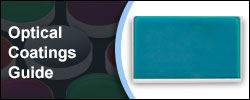
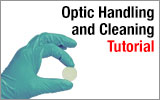


 Zoom
Zoom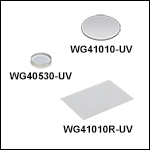
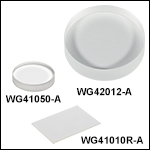


 UV Fused Silica Windows, 0.185 - 2.1 µm
UV Fused Silica Windows, 0.185 - 2.1 µm